Total US cases: 5,457,824
Average last 7 days: 48,764
Total US deaths: 163,595
Average last 7 days: 1,048
Source: COVID Tracking Project
My overall thesis is that under the present leadership the US as a whole is politically and socially incapable of bringing the coronavirus under control, as almost every other industrialized country has been able to do. That is very likely to change beginning next January 20. Before then, I expect there to be a yin and yang in the course of the pandemic, as areas in the US veer between “the pain threshold” at one extreme and complacency on the other. Together with a vaccine hopefully being available by next spring, at that time I am hopeful that the US will finally have beaten the virus.
Today let’s focus on infections, which lead hospitalizations by a couple of weeks, and deaths by a couple of weeks more.
Here is the overall regional picture:

As has been the case for several months, the South and to a lesser extent the West are the epicenters of the pandemic, while the Northeast has come close to containing the virus.
Breaking down each region by States, here is the South:
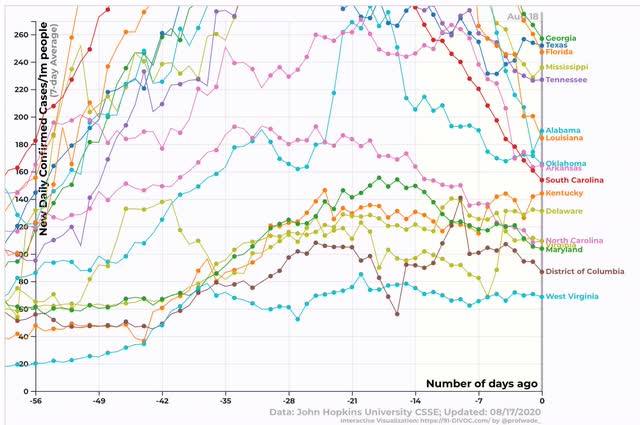
*Reported* cases in the Deep South, which were completely out of control a few weeks ago, have decreased substantially, while the Mid-Atlantic area centered on the DC metro area plus Kentucky has seen a significant increase after a period of relative complacency. (More on the significance of testing below).
in the West, Nevada and Idaho have made progress, while California is on a high plateau. After beating the virus early, Hawaii has had a major setback, again likely due to complacency. Other States in the region are doing reasonably well:
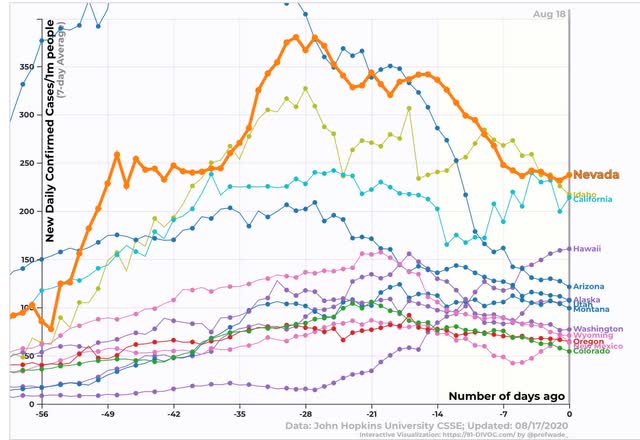
The Midwest is the area where complacency is currently leading to the most trouble, as all States have significantly higher levels of new infections than they did 8 weeks ago. Worse, only Minnesota and Ohio (highlighted) are currently trending downward:
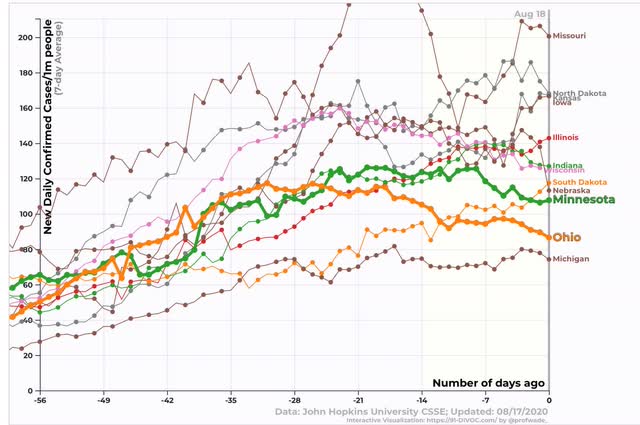
Finally, we come to the one region which on average has done very well, the Northeast. With the significant exception of Rhode Island, infections rates are lower than virtually *every* other State in *every* region of the country:
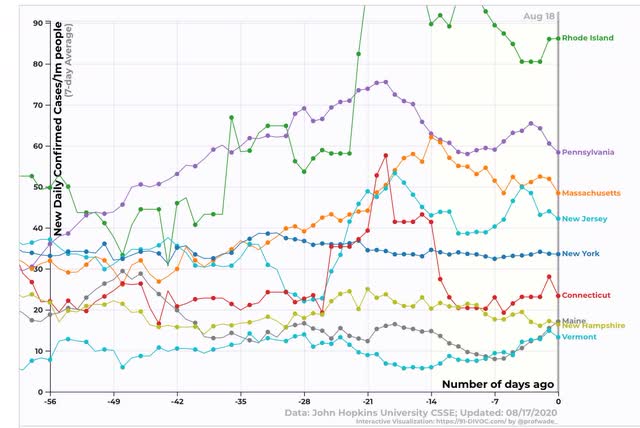
In the case of northern New England, Connecticut, and New York State, they have truly beaten the virus, although all the large States in the Northeast are not doing so well in comparison with neighboring Canada:
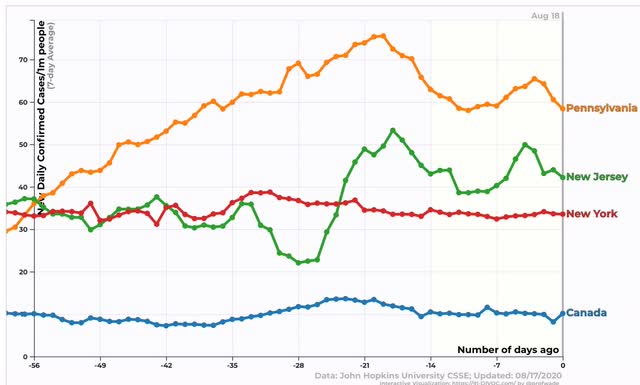
Only Maine, New Hampshire, and Vermont are comparable with our neighbors to the north.
But the picture in the majority of States is not as good (or “more bad”) than appears above, because testing has declined substantially in the South, and until a week ago in the West as well:
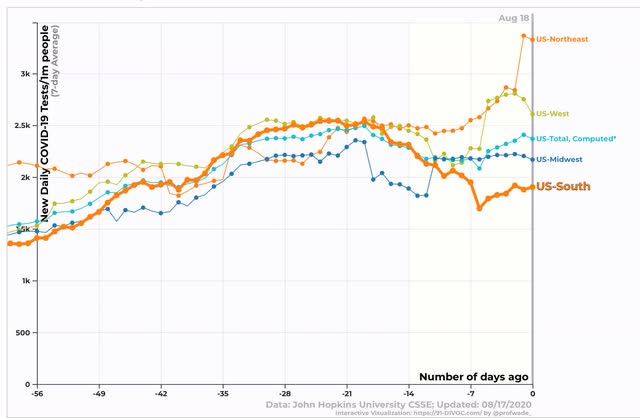
And only the Northeast meets the WHO’s threshold of under 5% positivity at which relaxing restrictions are deemed acceptable. As you can see, the South is failing terribly:
This means that in the West and Midwest, there are a significant number of missed cases, and in the South (especially the Deep South) the decline in new cases shown above may only be an artifact of fewer tests being done. In short, the situation there really remains virtually completely out of control.
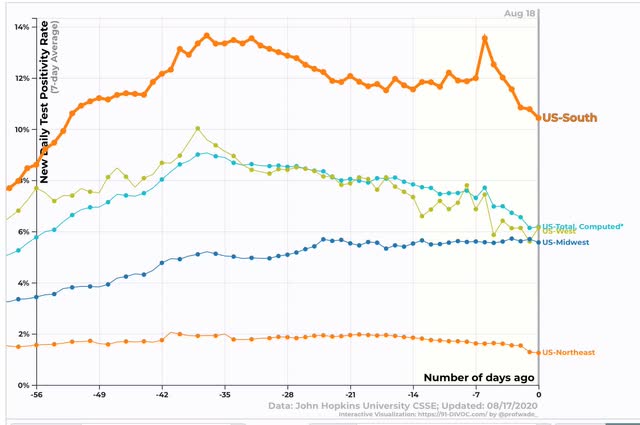








(At least in California, but probably US-wide.)
As COVID-19 cases surge, patients are dying at a lower rate. Here’s why
LA Times – August 9
When the number of people being sent to the hospital with COVID-19 began to creep up in Los Angeles County early this summer, officials warned that a major increase in deaths was inevitable. A record-breaking number of cases could result in a record-breaking number of deaths, they predicted.
But nearly two months later, that has not materialized. The coronavirus continues to kill hundreds of people every week in L.A. County, but the death toll has remained lower than expected.
The trend is due in part to younger people falling sick, as well as better control over the disease’s spread in high-risk settings, such as nursing homes. But doctors say there’s another factor pushing up survival rates: better treatments.
“It was so grim in the beginning,” said Dr. Armand Dorian, an ER physician and chief medical officer for Verdugo Hills Hospital at USC. “Now we actually have regimens of treatments that do help. … Since the beginning, say, February to now, we’ve learned a lot.”
The trends are not limited to L.A. County. In California, 3.6% of people diagnosed with COVID-19 between March and May died of the disease. Among those diagnosed between June 1 and Aug. 3, that figure dropped to 1.2%, according to a Times analysis of state data. Expanded testing, changing patient demographics and better patient care all played a role in that drop, experts say.
The statistic is what epidemiologists call the case-fatality rate: the number of deaths divided by the number of cases. This measures how deadly the disease is once people catch it — the chance of surviving. While the pandemic remains bleak, the lowered case-fatality rate is a glimmer of progress, experts say.
The case-fatality rate exists alongside another statistic: the mortality rate — deaths divided by the total population — which reflects the spread of the disease within the population.
In an interview with Axios released last week, President Trump discounted the nation’s mortality rate, which is worse than most other countries’, while lauding its case-fatality rate, which is better than most countries’.
But an improved case-fatality rate cannot offset the vast spread of the deadly virus, experts say. California’s mortality rate is rising as the state’s death toll from COVID-19 surpassed 10,000 on Thursday. If many people keep falling ill, then many people will die, even with improvements in survival rates. …
—
US Coronavirus Cases Are Rising Sharply, but Deaths Are Still Down
NY Times – July 3
After a minor late-spring lull, the number of confirmed coronavirus cases in the United States is once again on the rise. States like Arizona, Florida and Texas are seeing some of their highest numbers to date, and as the nation hurtles further into summer, the surge shows few signs of stopping.
And yet the virus appears to be killing fewer of the people it infects. In April and May, Covid-19, the disease caused by the coronavirus, led to as many as 3,000 deaths per day, and claimed the lives of roughly 7 to 8 percent of Americans known to have been infected. The number of daily deaths is now closer to 600, and the death rate is less than 5 percent.
In general, experts see three broad reasons for the downward trend in the rate of coronavirus deaths: testing, treatment and a shift in whom the virus is infecting. The relative contribution of these factors is not yet clear. And because death reports can lag diagnoses by weeks, the current rise in coronavirus cases could still portend increases in mortality in the days to come. …
(Heading toward Herd Immunity?)
… we are, to date, incapable of dealing with the COVID-19 pandemic. Though in great part due to a lack of leadership, itself a consequence of the Southern Strategy, this is in great part, also to do with large portions of the citizenry who do not believe in science, in the facts. Control of the COVID-19 pandemic is not possible as long as individual states refuse to follow the advice of scientific experts. How in the hell could any Governor of a State in the United States of America in the 21st Century go against the best scientific advice? What did they expect would happen? This is a consequence of Republican politicians making all those pilgrimages to Liberty University, Bob Jones University, Oral Roberts University, …; giving credence to anti-scientific, ant-intellectual beliefs; pandering to, according power to, right-wing Evangelical Christian sects in order to win their votes. We should have become more enlightened in these 50+ years that have passed by since Republicans initiated their Southern Strategy. Instead, we have been held back by southern Republican Politicians, Evangelical Christians. In tandem, these two have taken the Nation backward.
Why did our governor in California abandon his science/evidence based “rules” on the timing of relaxing restrictions? Well, he caved to pressure from the business community and the nut job contingent claiming restrictions are an over reaction. So here we are on a “high plateau” of new infections and, where I live anyway, complacency IS the rule. My unscientific observation: It’s remarkable what the passage of time does in people who have avoided the disease thus far. Some, probably subconsciously, behave as if the risks of contracting the virus is diminished, equally perversely, some begin to believe the narrative that the virus isn’t all that bad “because I haven’t gotten it yet”. Why are we so pathetically bad at dealing with reality?
If there is no vaccines soon, gonna have to go back to normal anyway. Deal with the fallout while it comes.
US South Positivity Rate looks odd. Seven day rolling average. The seventh day back is a huge spike. So either there was a huge positive that day or seven days before that it was like 0%. But seven days before that is quite small change. So almost certain that day had a huge, huge positivity. But the 7-day falls quickly after the peak, but that day should be in the average right to the end. But on the next point it should be out. Conclusion is that either the data is not worth much or US South is probably on a very strong decline in positivity.
Kwark,
“… Why are we so pathetically bad at dealing with reality?”
[Reality is a TV show, not science. Science makes our head hurt. TV good, science bad. OTOH, I believe Ken may be wrong about Evangelical Christians. There are a lot of fake Christians, but the only evangelicals that I know believe in consumerism rather than God.]
TV shows my age. Even my young beautiful wife, who is only 62 YO, is more absorbed by her iPad than TV. The younger they are then the smaller the screen in which their nose is buried. My excuse here is that it is raining outside this morning.
In classical Eastern terms contemporary westerners perceive reality primarily through the Anahata (heart chakra) and the Svadhisthana (ones feelings down there – front and back), but really few westerners perceive reality through the Sahasrara (pure consciousness).
Trump aides, meeting with lawmakers, reportedly said
a vaccine would be approved before the election
Trump administration officials met with congressional leaders last month and told them they would probably give emergency approval to a coronavirus vaccine before the end of Phase 3 clinical trials in the United States, perhaps as early as late September, according to two people briefed on the discussion.
The move would be highly unusual and would most likely prompt concerns about whether the administration is cutting corners on approvals for political purposes.
The two-hour meeting involving Treasury Secretary Steven Mnuchin; the White House chief of staff, Mark Meadows; House Speaker Nancy Pelosi; and Senator Chuck Schumer, the Democratic leader, took place on the evening of July 30 in Ms. Pelosi’s conference room.
During the discussion, the people briefed on it said, Mr. Meadows indicated that a vaccine being developed by AstraZeneca and Oxford University was the most likely candidate.
The projected timeline shows the administration’s hopes for a major victory against the pandemic before the election. It also suggests that officials have high expectations for the results of overseas drug trials, which began ahead of domestic ones.
Senior administration officials disputed the account, saying Mr. Meadows and Mr. Mnuchin were either being misrepresented or had been misunderstood on every major point. …
(Also…)
Trump hails FDA’s authorization of use of blood plasma, despite lack of clinical trials.
The Food and Drug Administration on Sunday authorized the emergency use of blood plasma from people who have recovered from coronavirus infections for the treatment of patients hospitalized with Covid-19.
The decision, which was delayed after top federal scientists urged further study of the treatment, was praised by President Trump at a news conference in which he said plasma was “very effective,” even though no rigorous clinical trials have proven that it works.
The president’s endorsement notwithstanding, convalescent plasma, however promising, has not been proven to work in randomized clinical trials, considered the best way of determining whether a treatment is effective. …
Trump considers fast-tracking UK Covid-19 vaccine before US election
via @financialtimes – August 23
The Trump administration is considering bypassing normal US regulatory standards to fast-track an experimental coronavirus vaccine from the UK for use in America ahead of the presidential election, according to three people briefed on the plan.
One option being explored to speed up the availability of a vaccine would involve the US Food and Drug Administration awarding “emergency use authorisation” (EUA) in October to a vaccine being developed in a partnership between AstraZeneca and Oxford university, based on the results from a relatively small UK study if it is successful, the people said.
The AstraZeneca study has enrolled 10,000 volunteers, whereas the US government’s scientific agencies have said that a vaccine would need to be studied in 30,000 people to pass the threshold for authorisation. AstraZeneca is also conducting a larger study with 30,000 volunteers, although the results from that will come after the smaller trial.
Making a vaccine available before the election could allow US president Donald Trump to claim he has turned the tide on a virus that has killed more than 170,000 Americans following widespread criticism of his handling of the pandemic. In his convention speech on Thursday night, Joe Biden, Mr Trump’s Democratic opponent, said that the US response to the virus was the “worst performance of any nation”.
However, if the Trump administration does rush through emergency authorisation ahead of the election by skirting normal government guidelines, it could dent already shaky public confidence in the safety of vaccines ahead of one of the largest mass-immunisation programmes in US history. …
China already using Covid-19 vaccine candidate on key workers, official says
via @scmpnews – August 23
China has been administering Covid-19 vaccine candidates to selected groups of workers, including medical staff and border inspection officials, for more than a month, a senior health official said on Sunday.
The government authorised the “emergency use” of the vaccine on July 22, Zheng Zhongwei, director of the National Health Commission’s (NHC’s) science and technology development centre, said in an interview with state broadcaster CCTV.
Zheng, who is also head of an expert panel that advises the government on Covid-19, said the decision to begin inoculating certain groups was “in line with the law”.
He did not say which product had been used or whether the programme involved more than one. Four of the seven vaccine candidates undergoing final phase testing around the world are manufactured by Chinese companies.
Health workers and border officials were chosen to be among the first people to receive the inoculations as they were more likely than most to get infected with the coronavirus, Zheng said.
“Most cases in China now are imported, so border officials are a high-risk group,” he said. …
—-
Russia, Expecting Plaudits for Vaccine, Is Miffed by Its Cool Reception
NY Times – August 23
MOSCOW — It was with great fanfare that President Vladimir V. Putin and other officials announced this month that a billion doses of a Russian vaccine for the new coronavirus would soon be rolled out, supposedly putting an end to the worst pandemic in a century.
But rather than taking a bow for saving the world with their vaccine, which they call Sputnik V, Russian health officials have found themselves on the defensive.
“Some foreign colleagues, who must have felt certain competition and competitive edges of Russia’s product, have been trying to express opinions that we find totally groundless,” the minister of health, Mikhail Murashko, told a news conference in Moscow.
Most of those “opinions” are based on the fact that Sputnik V has not been tested in late-stage, large, randomized control trials that are critical in establishing a vaccine’s safety and effectiveness. By skipping such trials, Russia is potentially endangering people to score propaganda points, health experts warn. …
China’s coronavirus vaccines are leaping ahead
Nature – July 31
– but face challenges as virus wanes
Chinese companies are at the forefront of global efforts to create a vaccine for the coronavirus, with more than half a dozen candidates in clinical development. Last week, Tianjin-based CanSino Biologics published results1 from an early-stage clinical trial showing that its vaccine is safe and can trigger an immune response.
Yet the companies could face difficulty as they try to push vaccines through phase III trials, a crucial stage of testing that is needed to prove efficacy and secure approval from regulators. These trials usually require tens of thousands of participants, and with the outbreak in China largely under control, companies are having to test their vaccines elsewhere. But researchers say they might still struggle to enrol so many participants and employ enough health-care professionals to collect data. …
Chinese vaccine-makers will face other challenges, too. Vaccines will probably face extra scrutiny, given the country’s opaque regulatory system and previous vaccine scandals, say scientists. In 2018, hundreds of thousands of children reportedly received defective diptheria, tetanus and whooping cough vaccines.
As the country where the coronavirus outbreak began, China was fast out of the gate in developing vaccines. CanSino’s offering is made from a common-cold virus, tweaked to mimic the coronavirus. Sinopharm, a state-owned pharmaceutical company in Beijing, is developing two vaccines made using particles of the coronavirus that have been inactivated so that they can no longer cause disease. The company said in press releases in June that both vaccines had produced antibodies in all participants in preliminary phase I and II trials. And Beijing-based company Sinovac has announced similarly promising results for its own inactivated-virus vaccine. …
CanSino is also poised to launch a phase III trial. But the Chinese government has already said that its vaccine can be used by the military — making CanSino the first company to have a vaccine for COVID-19 approved for limited use in people. China has worked hard “to generate an efficient vaccine as soon as possible and to be transparent” when doing so, says Stéphane Paul, a vaccine researcher at the University of Lyon in France. …
Why Are Coronavirus Cases Decreasing? Experts Say Restrictions Are Working
NY Times – August 24
(graphics at the link)
NY Times – August 24
Infection rates remain among the world’s highest, but numbers are down. All states driving the decrease have at least some local mask mandates.
United States …….. On Aug. 23 …. 14-daychange Trend
New cases …………….. 32,340 ……………-22%
New deaths ………… 446 ………………-5%
Lower working memory capacity linked to non-compliance with social distancing guidelines
….during the early stage of the coronavirus outbreak
PsyPost – July 11
New research provides preliminary evidence that working memory is associated with engaging in social distancing in the early stages of the coronavirus pandemic. The new study has been published in the Proceedings of the National Academy of Sciences.
On March 11th, 2020, the World Health Organization declared the outbreak of the novel coronavirus SARS‐CoV‐2 to be a global pandemic. Governments around the world urged people to follow preventive health measures such as frequent hand washing and physical distancing. But not everyone abided by the safety guidelines.
“At the moment, successful containment of the COVID-19 outbreak critically relies on people’s voluntary compliance with social distancing guidelines. However, there is widespread non-compliance in our society, especially during the early stage of this pandemic (and more recently after reopening),” said study author Weizhen Xie (Zane), a postdoctoral research fellow at the National Institute of Neurological Disorders and Stroke.
The researcher noted that there have been numerous media reports about Americans failing to physically distance themselves from one another in public spaces.
“As a researcher in cognitive psychology, I feel that it is our duty to figure out why some people follow the developing norm of social distancing while others ignore it. Addressing this issue may help mitigate the current public health crisis due to the COVID-19,” Xie said.
In two studies, the researchers surveyed 850 U.S. residents between March 13 and March 25, 2020 — the first two weeks following the U.S. presidential declaration of a national emergency about the COVID-19 pandemic. In addition to collecting demographic information and assessing social distancing compliance, the surveys included assessments of working memory, personality, mood, and fluid intelligence. …